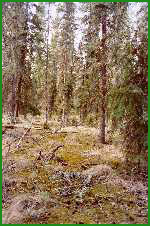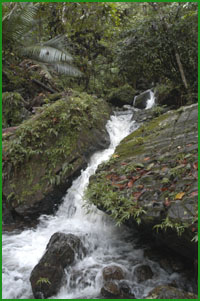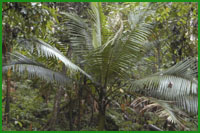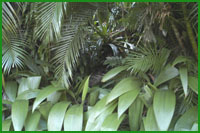For Students
Sometimes you hear the words "tropical" and "temperate" associated with rain forests. The difference is in the location. If the rain forest is close to the equator, it is considered tropical. If the rain forest is farther away from the equator (between the Arctic Circle and the Tropic of Cancer or the Antarctic Circle and the Tropic of Capricorn), then the forest is considered to be temperate.
Since Alaska and the Pacific Northwest’s rain forests are found between the Arctic Circle and the Tropic of Cancer, these forests are temperate. All temperate rain forests share similar characteristics, but different plants and animals populate each.
Rain Forest Recipe
The key ingredients:
- Rain, and lots of it (or other precipitation, such as snow, drizzle, mist, or fog. The area must receive a minimum of 250cm of moisture (100 inches) per year. The moist maritime climate keeps the landscape wet most of the year, resulting in an annual precipitation of about 300cm (120 inches).
- Forest (without trees we might have grasslands, but it wouldn't be rain forest).
Precipitation and Climate
Both tropical and temperate rain forests are very lush and wet. The tropical rain forest has downpours at the rate of two inches an hour adding up to some 400 inches of rain per year. It rains a lot in the temperate rain forest, too -- about 100 inches per year. And even more moisture comes from the coastal fog that hovers among the trees.
Tropical rain forests are warm and moist; while temperate rain forests are cool.
| Tropical | Temperate |
| Temperatures | warm | cool |
| Number of tree species | many (hundreds) | few (10-20) |
| Types of leaves | broadleaf | needles |
| Age of trees | 50-100 years | 500-1000 years |
| Epiphytes | lots of different kinds including orchids and bromeliads | mostly mosses
and ferns |
| Decomposition rate | rapid | slow |

Temperate Rain Forests
The temperate rain forest in Alaska and along the Pacific Northwest are some of the most spectacular examples of temperate rain forest in the world. This ecosystem stretches along the Pacific Coast from Oregon to Alaska. Other countries that have temperate rain forests include Chile, New Zealand, and Norway.
What defines a rain forest quite simply is rain--lots of it. Precipitation here ranges from 140 to 167 inches --12 to 14 feet -- every year. The mountains to the east also protect the coastal areas from severe weather extremes. Seldom does the temperature drop below freezing in the rain forest and summertime highs rarely exceed 80 F.
What Does It Look Like?
Imagine a forest of trees so huge, tall, and ancient that we all look like little children beside them. Imagine a world of vivid green moss, arching ferns, and a mass of plants so thick it's impossible to see the soil beneath it.
Temperate rain forests progress through a number of stages: mature, old growth, and ancient old growth.
Characteristics that you are likely to notice in old growth, temperate rain forests are:
- trees that range in age from small seedlings just starting out, to very old and grand trees that have lived many hundreds of years
- many canopy layers (each tree's upper levels of vegetation); large standing snags (broken trees, usually dead)
- large logs on the forest floor and in streams
- an abundance of plants growing on other plants (epiphytes and parasites)
- a dense understory of shrubbery
- and an abundance of green in more shades than you can count, no matter what the time of year
Lots of Biomass!

There is a huge amount of biomass (material made by living things) in this forest. Some of it is alive, some of it was alive, and some of it will be recycled and become part of a new life. The sheer mass of stuff that was alive at some stage (the organic matter) is staggering.
The sheer size and age these trees can attain, in combination with all the other plants and animals found here, make this one of the highest biomass producing communities on earth.
One interesting thing about all this biomass is that there isn't a lot of diversity (or different kinds) of life. In other words, there are large amounts of the same few species. It doesn't take long to learn some of the key species that you will see over and over and over again.
What Plant Is That?
Many of the world's temperate rain forests of the world are a mix of both deciduous (broad-leafed) and coniferous (scaly or needle-leafed) trees. The dominance of conifers in our rain forest is one characteristic that distinguishes temperate rain forests. Regardless of what they look like, rain forests all over the world are extremely important to the Earth's health in contributing to the diversity of life.
The dominant species in America’s temperate rain forests are Sitka spruce and western hemlock—some grow to tremendous size, reaching 300 feet in height and 23 feet in circumference. Douglas-fir, western redcedar, bigleaf maple, red alder, vine maple, and black cottonwood are also found throughout the forest. Nearly every bit of space is taken up with a living plant.
The cones of the Sitka spruce tree are an especially important food source to crossbills and other birds. Its foliage, however, does not make a pleasant meal for any animals, since the needles are unusually sharp and prickly. The deer and elk which inhabit the temperate rain forest during the winter prefer to feed on the softer needles of western hemlock and western redcedar. These two conifers are very shade-tolerant and grow very large, living for over 400 years. The wood of the western redcedar is resistant to decay and is often used for shingles, boats, and other products that will be exposed to the weather.
Some plants even live on others. These are the epiphytes, plants that do not come into contact with the Earth but also are not parasites. They are partly responsible for giving the rain forest its "jungly" appearance. Mosses, lichens, and ferns cover just about anything else.
Because of this dense ground cover, it’s hard for seedlings to get a start. Many seedlings germinate on fallen, decaying trees. These fallen trees are called “nursery logs.” As the seedlings grow they send their roots down the log to the ground. Eventually the log rots completely away and a row of young trees is left, up on stilt-like roots, all in a row.
The thick and protective vegetation also provides excellent habitats for the animals of the rain forest. In turn, they contribute to the health of the forest by keeping the rampant vegetation under control by browsing.
Tropical Rain Forests
Where In the World . . .?
Tropical rain forests are located in the warm regions south of the Tropic of Cancer and north of the Tropic of Capricorn. Tropical rain forests have the greatest biodiversity, and the only tropical rain forest in the United States is found on the island of Puerto Rico.
Tropical Rain Forest Climate

Tropical rain forests are warm areas that receive a great deal of rainfall. Average temperatures range from 70-90 degrees F. Rainfall ranges from 60-200 inches per year. Relative humidity is typically 70% in the daytime and 95% at night.
Are All Tropical Forests Rain Forests?
Only a small percentage of the tropical forests are rain forests. To be a tropical rain forest, forested areas must:
- Lie between the Tropic of Cancer and the Tropic of Capricorn
- Receive rainfall regularly throughout the year (80-400 inches per year)
- Remain warm and frost free all year long (mean temperatures are between 70° and 85°F) with very little daily fluctuation
Soil and Nutrient Recycling

Most tropical rain forest soils are relatively poor in nutrients. Millions of years of weathering and torrential rains have washed most of the nutrients out of the soil. More recent volcanic soils, however, can be very fertile. Tropical rain forest soils contain less organic matter than temperate forests and most of the available nutrients are found in the living plant and animal material. Nutrients in the soil are often in forms that are not accessible by plants.
Constant warmth and moisture promote rapid decay of organic matter. When a tree dies in the rain forest, living organisms quickly absorb the nutrients before they have a chance to be washed away. When tropical forests are cut and burned, heavy rains can quickly wash the released nutrients away, leaving the soil even more impoverished.
Layers in the Rain Forest
Tropical rain forests have four layers:
Emergent Layer -- These giant trees thrust above the dense canopy layer and have huge mushroom-shaped crowns. These trees enjoy the greatest amount of sunlight but also must endure high temperatures, low humidity, and strong winds.
Canopy Layer -- The broad, irregular crowns of these trees form a tight, continuous canopy 60 to 90 feet above the ground. The branches are often densely covered with other plants (epiphytes) and tied together with vines (lianas). The canopy is home to 90% of the organisms found in the rain forest; many seeking the brighter light in the treetops.
Understory -- Receiving only 2-15% of the sunlight that falls on the canopy, the understory is a dark place. It is relatively open and contains young trees and leafy herbaceous plants that tolerate low light. Many popular house plants come from this layer. Only along rivers and roadways and in treefall and cut areas is sunlight sufficient to allow growth to become thick and impenetrable.
Forest Floor -- The forest floor receives less than 2% of the sunlight and consequently, little grows here except plants adapted to very low light. On the floor is a thin layer of fallen leaves, seeds, fruits, and branches that very quickly decomposes. Only a thin layer of decaying organic matter is found, unlike in temperate deciduous forests.
Biologically Diverse!

Biological diversity, very simply, refers to all of the different kinds of life on Earth. Also called biodiversity, biological diversity is often used to refer to the total number of different species on Earth. A collection of this biodiversity would include human beings, Bengal tigers, sugar maples, oyster mushrooms, bacteria, and the millions of other living organisms found on Earth. Conservative estimates of the number of species on Earth range from 5 to7 million but some scientists estimate as many as 30 million! With only about 1.6 to 2 million of these species having been studied (many only at the most basic level) and given a name, much still needs to be learned about the diversity of life on Earth.
Much of the Earth's biodiversity is concentrated in the tropics. Some scientists estimate that 50 percent of all species on the planet are found in tropical rainforests that comprise only 6 to 7 percent of the Earth's land surface. Given the rapid rate at which tropical rainforests are being cut, it is estimated that up to 20 percent of the Earth's biodiversity may become extinct in our lifetime!
Loss of this biodiversity means we would not only lose rich and beautiful ecosystems but we might also lose plants and other organisms that could improve or enrich our lives. Already the tropical forests have provided humankind with food crops we enjoy daily such as tomatoes, peppers, corn, rice, coconut, banana, coffee, cocoa, cassava (tapioca), beans, and sweet potatoes, to name but a few. Tropical biodiversity has also provided us with many medicines used to treat such diseases as malaria. How many more valuable products are waiting in the tropical forests to be discovered before they disappear?
Tropical rain forests are being cut at an alarming rate. Although estimates vary, some scientists believe that we are losing an area of rain forest the size of Pennsylvania each year. If deforestation continues at this rate, we may lose rain forests altogether within the next one hundred years.
Tropical deforestation occurs for a number of reasons. As human populations increase in tropical regions, people move away from the overcrowded cities into the forest areas where they practice small-scale farming. Commercial agricultural projects may require conversion of large plots of rain forest land and may cause more permanent damage.
In Puerto Rico, the Caribbean National Forest protects and restores the unique tropical rain forest. Also, the International Institute for Tropical Forestry has many scientists studying how these special and rich forests can be managed and protected in the future.
|







